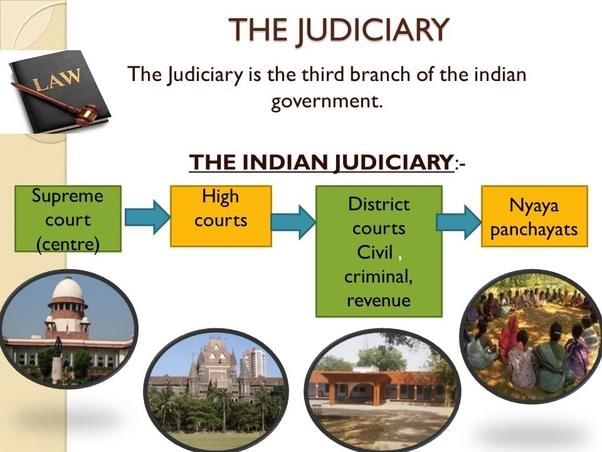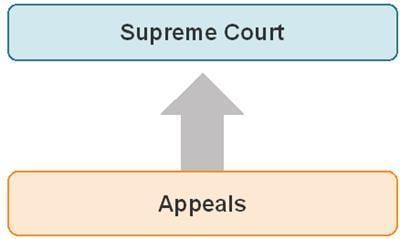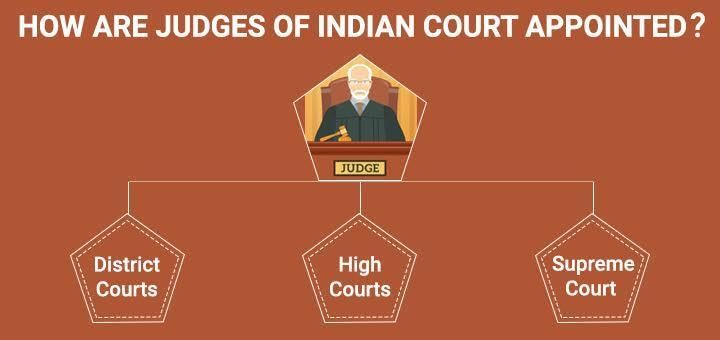NCERT Summary: Judiciary - 1 | Indian Polity for UPSC CSE PDF Download
Introduction
- Many times, courts are seen only as arbitrators in disputes between individuals or private parties. But the judiciary performs some political functions also.
- Judiciary is an important organ of the government. The Supreme Court of India is in fact, one of the very powerful courts in the world. Right from 1950 the judiciary has played an important role in interpreting and in protecting the Constitution. In this chapter you will study the role and importance of the judiciary.

1. Why do we need an Independent Judiciary?
- In any society, disputes are bound to arise between individuals, between groups and between individuals or groups, and between individuals or groups and government. All such disputes must be settled by an independent body in accordance with the principle of rule of law.
- This idea of rule of law implies that all individuals- rich and poor, men or women, forward or backward castes-are subjected to the same law.
- The principal role of the judiciary is to protect rule of law and ensure supremacy of law. It safeguards rights of the individual, settles dispute in accordance with the law, and ensures that democracy does not give way to individual or group dictatorship. In order to be able to do all this, it is necessary that the judiciary is in dependent of any political pressures.
2. Independence of Judiciary
Simply stated independence of judiciary means that:
(i) The other organs of the government like the executive and legislature must not restrain the functioning of the judiciary in such a way that it is unable to do justice.
(ii) The other organs of the government should not interfere with the decision of the judiciary.
(iii) Judges must be able to perform their functions without fear or favour.
- Independence of the judiciary does not imply arbitrariness or absence of account-ability. Judiciary is a part of the democrat political structure of the country. It is therefore accountable to the Constitution, to the democrat traditions, and to the people of the country.
- The Indian Constitution has ensured the independence of the judiciary through a number of measures. The legislature is not involved in the process of appointment of judges. Thus, it was believed that party polities would not play a role in the process of appointments. In order to be appointed as a judge, a person must have experience as a lawyer and/or must be well versed in law. Political opinions of the person or his/her political loyalty should not be the criteria for appointments to judiciary.
- The judges have a fixed tenure. They hold office till reaching the age of retirement. Only in exceptional cases, judges may be removed. But otherwise, they have security of tenure. Security of tenure ensures that judges could function without fear or favour. The Constitution prescribes a very difficult procedure for removal of judges. The Constitution makers believed that a difficult procedure of removal would provide security of office to the members of judiciary.
- The judiciary is not financially dependent on either the executive or legislature. The Constitution provides that the salaries and allowances of the judges are not subjected to the approval of the legislature. The actions and decisions of the judges are immune from personal criticisms. The judiciary has the power to penalize those who are found guilty of contempt of court. This authority of the court is seen as effective protection to the judges from unfair criticism.
- Parliament cannot discuss the conduct of the judges except when the proceeding to remove a judge is being carried out. This gives the judiciary independence to adjudicate without fear of being criticized.
Appointment of Judges
- The appointment of judges has never been free from political controversy. It is part of the political process. It makes a difference who serves in the Supreme Court and High Court- a difference in how the Constitution is interpreted. The political philosophy of the judges, their views about active and assertive judiciary or controlled and committed judiciary have an impact on the fate of the legislations enacted. Council of Ministers, Governors and Chief Ministers and Chief Justice of India-all influence the process of judicial appointment.
- As far as the appointment of the Chief Justice of India (CJI) is concerned, over the years, a convention had developed whereby the senior-most judge of the Supreme Court was appointed as the Chief Justice of India. This convention was however broken twice. In 1973 A.N. Ray was appointed as CJI superseding three senior Judges. Again, Justice M.H. Beg was appointed superseding Justice H.R. Khanna (1975).
- The other Judges of the Supreme Court and the High Court are appointed by the President after ‘consulting’ the CJI. This, in effect, meant that the final decisions in matters of appointment rested with the Council of Ministers.
- This matter came up before the Supreme Court again and again between 1982 and 1998. Initially, the court felt that role of the Chief Justice was purely consultative. Then it took the view that the opinion of the Chief Justice must be followed by the President.
- Finally, the Supreme Court has come up with a novel procedure: It has suggested that the Chief Justice should recommend names of persons to be appointed in consultation with four senior-most judges of the Court. Thus, the Supreme Court has established the principle of collegiality in making recommendations for appointments. At the moment therefore, in matters of appointment the decision of the group of senior judges of the Supreme Court carries greater weight. Thus, in matters of appointment to the judiciary, the Supreme Court and the Council of Ministers play an important role.
➢ Removal of Judges
- The removal of judges of the Supreme Court and the High Court’s is also extremely difficult. A judge of the Supreme Court or High Court can be removed only on the ground of proven misbehavior or incapacity. A motion containing the charges against the judge must be approved by special majority in both Houses of the Parliament.
- Removal of a judge is a very difficult procedure and unless there is a general consensus among Members of the Parliament, a judge cannot be removed. It should also be noted that while in making appointments, the executive plays a crucial role; the legislature has the powers of removal. This has ensured both balance of power and independence of the judiciary.
- So far, only one case of removal of a judge of the Supreme Court came up for consideration before the Parliament. In that case, though the motion got two-thirds majority, it did not have the support of the majority of the total strength of the House and therefore, the judge was not removed.
➢ Structure of the Judiciary
- The Constitution of India provides for a single integrated judicial system. This means that unlike some other federal countries of the world. India does not have separate State courts.
- The structure of the judiciary in India is pyramidal with the Supreme Court at the top, High Courts below them and district and subordinate courts at the lowest level. The lower courts function under the direct superintendence of the higher courts.
➢ Jurisdiction of Supreme Court
- The Supreme Court of India is one of the very powerful courts anywhere in the world. However, it functions within the limitations imposed by the Constitution.
- The functions and responsibilities of the Supreme Court are defined by the Constitution. The Supreme Court has specific jurisdiction or scope of powers.
Original Jurisdiction
- Original jurisdiction means cases that can be directly considered by the Supreme Court without going to the lower courts before that. Cases involving federal relations go directly to the Supreme Court.
- The Original Jurisdiction of the Supreme Court establishes it as an umpire in all disputes regarding federal matters. In any federal country, legal disputes are bound to arise between the Union and the States, and among the States themselves.
- The power to resolve such cases is entrusted to the Supreme Court of India. It is called original jurisdiction because the Supreme Court alone has the power to deal with such cases. Neither the High Court’s nor the lower courts can deal with such cases. In this capacity, the Supreme Court not just settles disputes but also interprets the powers of Union and State government as laid down in the Constitution.

(i) Unsuccessful Attempt to Remove a Judge
- In 1991 the first-ever motion to remove a Supreme Court Justice was signed by 108 members of Parliament. Justice Ramaswamy, during his tenure as the Chief Justice of the Punjab High Court was accused of misappropriating funds.
- In 1992, a year after the Parliament had started the impeachment proceedings, a high-profile inquiry commission consisting of Judges of Supreme Court found Justice V. Ramaswamy “guilty of willful and gross misuses of office and moral turpitude by using public funds for private purposes and reckless disregard of statutory rules” while serving as Chief Justice of Punjab and Haryana. Despite this strong indictment, Ramaswamy survived the parliamentary motion recommending removal. The motion recommending his removal got the required two-third majority among the members who were present and voting, but the Congress party abstained from voting in the House.
- Therefore, the motion could not get the support of one-half of the total strength of the House.
(ii) Writ Jurisdiction
- Any individual, whose fundamental right has been violated, can directly move the Supreme Court for remedy. The Supreme Court can give special orders in the form of writs.
- The High Courts can also issue writs, but the persons whose rights are violated have the choice of either approaching the High Court or approaching the Supreme Court directly. Through such writs, the Courts can give orders to the executive to actor not to act in a particular way.
|
151 videos|780 docs|202 tests
|
FAQs on NCERT Summary: Judiciary - 1 - Indian Polity for UPSC CSE
| 1. What is the process of appointment of judges in the judiciary? |  |
| 2. Who is responsible for recommending suitable candidates for judge appointments? |  |
| 3. Can the President reject the recommendations made by the collegium system? |  |
| 4. What is the significance of the original jurisdiction of the judiciary? |  |
| 5. What is the role of the judiciary in maintaining the independence of the appointment process? |  |























